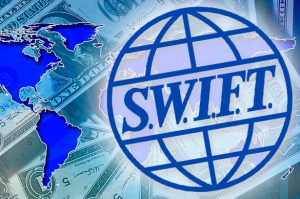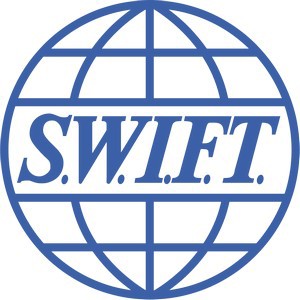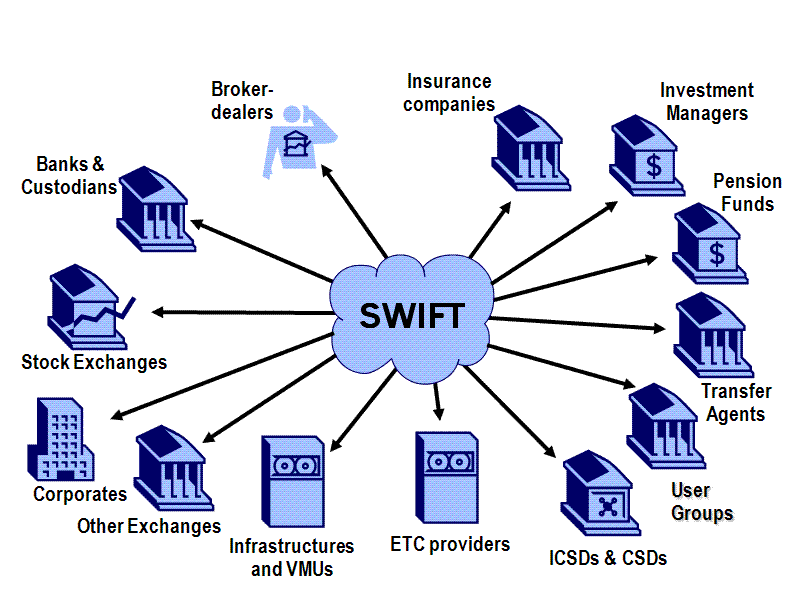Carder
Professional
- Messages
- 2,619
- Reaction score
- 1,869
- Points
- 113
A new whirlwind of anti-Russian sanctions could seriously affect the country's economy. The fact is that the United States intends to disconnect Russia from SWIFT, an international system for the exchange of financial flows and messages.
It is needed so that banks can quickly and with maximum security transfer payments to all countries. Payments are sent in the established format, which significantly increases the speed of the transfer, reduces the commission and makes the transfer secure. The number of SWIFT participants is over 11 thousand companies and banks. Russian banks rank second in terms of the number of payments and 15th in terms of the volume of transactions.
To date, the practice has only one case of disconnecting a country from SWIFT. It was Iran in 2012. The European Union has complied with US regulations. The country suffered significant financial losses, however, it was not broken. The disconnection of Russia from SWIFT also brings financial isolation and a halt to various financial processes related to imports and exports.
If the sanctions are nevertheless introduced, they will affect some banks, and there are more than 500 of them in Russia. While some rush into panic and say that disconnecting from SWIFT is the collapse of the country's financial system, others are confident that Russia can do without it. due to the presence of its own software - SFPS, developed jointly with the BRICS countries.
Article content

SWIFT situation
The new package of anti-Russian sanctions adopted by the US Congress caused a wave of indignation and fear. Washington announced the possible disconnection of Russia from SWIFT services. Despite this, Moscow remains calm, as the SPFS (system for transfer of financial messages) system can be tried as an alternative. More than 300 Russian banks are already working on it. The BRICS countries are gradually joining it. SPFS is not subject to external influences, which will ensure its stability. However, like the Russian Mir system, SPFS is damp.
While Europe refuses to comply with the US order to disconnect Russia from SWIFT. This will be regarded as a declaration of war, and since Russia is still a nuclear power, such actions can lead to "bad" consequences.
Disconnecting Russia from SWIFT is the second step in anti-Russian sanctions from the White House. The first is that Washington wants to prohibit American companies from buying up federal loan bonds (OFZ) and stop operations with existing Russian securities. Considering that about 40% of OFZs are owned by foreign investors, a massive outflow from this instrument could bring down the ruble again. The situation of disconnection from SWIFT can affect almost every person who uses SWIFT to quickly exchange payment messages.
Without notification of transactions, payments will take longer and more expensive, which is not beneficial for either business or an ordinary user. The head of the Central Bank E. Nabiullina said that in case Russia is disconnected from SWIFT, 90% of domestic ATM terminals are ready to service cards of the Russian payment system Mir. At the same time, it is silent that the World is a young system. Abroad, payments are made using the Maestro system, which has enough restrictions and limits.
Thus, the likelihood of Russia disconnecting from SWIFT is small, but it is becoming more and more real. European countries do not want such a turn of events, because they also use this system. Here we are not talking about the disconnection of a particular country, but about the fact that any state may be subject to sanctions due to any political or economic considerations. Almost all countries will see that they are their economic independence - it is just an appearance that does not have a solid foundation.
Many experts are sure of one thing, that cash flow will not decrease, but will be redirected to less reliable and controlled systems that are difficult to assess. And this, in turn, will be in the hands of terrorists and cybercriminals.
Can I send money abroad without SWIFT?
There are alternative ways. Let's consider the most optimal ones:
Thus, if SWIFT is disabled, transfers from Russia and to Russia can still be sent in other ways, however, this will suspend the cash flow.
What operations will be unavailable when disconnected from SWIFT?
At first, the flow of transfers in foreign currency will dry up. It is clear that it is impossible even technically to turn off all Russian banks, so the main stream will be diverted to the banks remaining in SWIFT. Interbank communications will also stop. SWIFT works as a kind of "chat", where banks decide in what way the cash flow will be forwarded, where problems with transfers are solved, and so on.
As you know, the European ban on the delivery of animal and plant products to Russia has led to an increase in the production of dairy and meat products. In the case of SWIFT and the desire of the United States to “strangle” the financial segment, the effect can be reversed.
If Western partners do not want to cooperate with Russia, then there are partners in the East. Together with the BRICS countries, Russia is able to create a “local” SWIFT, which will already deal a blow to the finances of the West and the United States. The new analogue will no longer be able to be controlled like SWIFT, so this scenario is unlikely to please the initiators of anti-Russian sanctions.
It is needed so that banks can quickly and with maximum security transfer payments to all countries. Payments are sent in the established format, which significantly increases the speed of the transfer, reduces the commission and makes the transfer secure. The number of SWIFT participants is over 11 thousand companies and banks. Russian banks rank second in terms of the number of payments and 15th in terms of the volume of transactions.
To date, the practice has only one case of disconnecting a country from SWIFT. It was Iran in 2012. The European Union has complied with US regulations. The country suffered significant financial losses, however, it was not broken. The disconnection of Russia from SWIFT also brings financial isolation and a halt to various financial processes related to imports and exports.
If the sanctions are nevertheless introduced, they will affect some banks, and there are more than 500 of them in Russia. While some rush into panic and say that disconnecting from SWIFT is the collapse of the country's financial system, others are confident that Russia can do without it. due to the presence of its own software - SFPS, developed jointly with the BRICS countries.
Article content
- SWIFT situation.
- Can I send money abroad without SWIFT?
- What operations will be unavailable when disconnected from SWIFT?

SWIFT situation
The new package of anti-Russian sanctions adopted by the US Congress caused a wave of indignation and fear. Washington announced the possible disconnection of Russia from SWIFT services. Despite this, Moscow remains calm, as the SPFS (system for transfer of financial messages) system can be tried as an alternative. More than 300 Russian banks are already working on it. The BRICS countries are gradually joining it. SPFS is not subject to external influences, which will ensure its stability. However, like the Russian Mir system, SPFS is damp.
While Europe refuses to comply with the US order to disconnect Russia from SWIFT. This will be regarded as a declaration of war, and since Russia is still a nuclear power, such actions can lead to "bad" consequences.
Disconnecting Russia from SWIFT is the second step in anti-Russian sanctions from the White House. The first is that Washington wants to prohibit American companies from buying up federal loan bonds (OFZ) and stop operations with existing Russian securities. Considering that about 40% of OFZs are owned by foreign investors, a massive outflow from this instrument could bring down the ruble again. The situation of disconnection from SWIFT can affect almost every person who uses SWIFT to quickly exchange payment messages.
Without notification of transactions, payments will take longer and more expensive, which is not beneficial for either business or an ordinary user. The head of the Central Bank E. Nabiullina said that in case Russia is disconnected from SWIFT, 90% of domestic ATM terminals are ready to service cards of the Russian payment system Mir. At the same time, it is silent that the World is a young system. Abroad, payments are made using the Maestro system, which has enough restrictions and limits.
Thus, the likelihood of Russia disconnecting from SWIFT is small, but it is becoming more and more real. European countries do not want such a turn of events, because they also use this system. Here we are not talking about the disconnection of a particular country, but about the fact that any state may be subject to sanctions due to any political or economic considerations. Almost all countries will see that they are their economic independence - it is just an appearance that does not have a solid foundation.
Many experts are sure of one thing, that cash flow will not decrease, but will be redirected to less reliable and controlled systems that are difficult to assess. And this, in turn, will be in the hands of terrorists and cybercriminals.
Can I send money abroad without SWIFT?
There are alternative ways. Let's consider the most optimal ones:
- From card to card. Russian banks often use card-to-card turbo transfers. So, from a Russian bank card, you can send money to a card of another state, knowing only its number.
- Electronic payment systems. Yandex.Money, WebMoney, Qiwi work in many foreign countries. Transfers are made directly from home. It is enough to have access to the Internet, a card and a virtual wallet. The whole process takes no more than 10 minutes, and the speed of money transfer is almost instantaneous. The recipient also withdraws from the wallet to his foreign account or card and withdraws money. The disadvantages are the still high commission for large amounts and there are limits on transfers.
- International money transfer systems. They are among the fastest and most popular, and also work in all countries of the world. These include Western Union, Money Gram, Contact, Zolotaya Korona. To send, it is enough to indicate the name of the recipient, the amount and the country. After sending, the sender receives a control number, which he informs the recipient. At the nearest service point, the recipient indicates the number and receives the transfer. Delivery speed varies from 15 minutes to a day. The maximum amount for one transfer cannot exceed $ 5,000 or its equivalent in another currency.
- Cryptocurrency. This is the newest and most talked about option for sending money anywhere in the world. While some are wary of it, others are already active users who have managed not only to get a cryptocurrency, but also to make money on the growth of its rate. For transfers in cryptocurrency, you need to install the wallet on your PC. Next, the selected cryptocurrency, for example, bitcoin, is purchased on the exchange and forwarded to the recipient's wallet. While in Russia, the attitude towards bitkons is ambiguous. At the legislative level, currency is prohibited. The country's authorities do not trust the “air currency, which is not tracked, has high volatility and is not backed by real assets.
Thus, if SWIFT is disabled, transfers from Russia and to Russia can still be sent in other ways, however, this will suspend the cash flow.
What operations will be unavailable when disconnected from SWIFT?
At first, the flow of transfers in foreign currency will dry up. It is clear that it is impossible even technically to turn off all Russian banks, so the main stream will be diverted to the banks remaining in SWIFT. Interbank communications will also stop. SWIFT works as a kind of "chat", where banks decide in what way the cash flow will be forwarded, where problems with transfers are solved, and so on.
As you know, the European ban on the delivery of animal and plant products to Russia has led to an increase in the production of dairy and meat products. In the case of SWIFT and the desire of the United States to “strangle” the financial segment, the effect can be reversed.
If Western partners do not want to cooperate with Russia, then there are partners in the East. Together with the BRICS countries, Russia is able to create a “local” SWIFT, which will already deal a blow to the finances of the West and the United States. The new analogue will no longer be able to be controlled like SWIFT, so this scenario is unlikely to please the initiators of anti-Russian sanctions.


